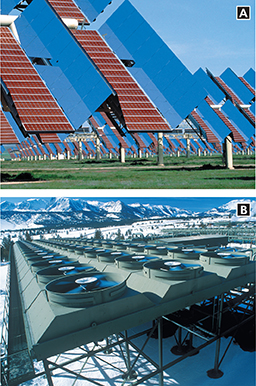Solar Energy
The amount of energy from the sun that reaches Earth in one hour is more than the amount of energy used by the world's population in a year. Sunlight that is converted into usable energy is called solar energy. Passive solar designs use sunlight to heat a building without using machinery. Sunlight passing through the windows of a house may be absorbed by walls that then radiate thermal energy to warm the house.
In an active solar energy system, sunlight heats flat collection plates through which water flows. The heated water may be used directly, or it may be used to heat the house. Sunlight can also be converted into electrical energy by solar cells, also known as photovoltaic cells, like those shown in Figure 18A. Concentrating solar power (CSP) plants use mirrors to focus sunlight to produce electricity.
The benefits of solar energy depend on the climate. Solar energy is nonpolluting, but for areas where cloudy days are frequent, solar energy is less practical.
Geothermal Energy
Geothermal energy is thermal energy beneath Earth's surface. In some regions, especially near volcanoes, geothermal energy is used to generate electicity. The geothermal power plant in Figure 18B pumps water into the ground, where it turns into steam. The steam is then used to drive electric generators. Geothermal energy is nonpolluting, but is not widely available.
Other Renewable Resources
Sunlight causes plants to grow, converting electromagnetic energy into chemical energy. The chemical energy stored in living things is called biomass energy. Biomass can be converted directly into thermal energy. For example, many people around the world burn wood or peat to heat their homes or for cooking. Also, agricultural wastes such as corn stalks can be converted into a high-energy alcohol fuel that can be added to gasoline for cars.
Wind energy is another renewable energy source. Wind turbines convert the kinetic energy of wind into electrical energy. Wind energy is actually a form of solar energy. Energy from the sun causes uneven heating of air, which, in turn, causes differences in air pressure. Winds blow from areas of higher pressure to areas of lower pressure.
A form of hydrogen is also the most likely raw material for another future source of energy, nuclear fusion. The process of fusion will probably produce little pollution or radioactive waste. Scientists have been working on sustained fusion for years, but many challenges remain.
Figure 18 Solar and geothermal energy plants use renewable resources to generate electricity. A A concentrating solar power (CSP) plant uses solar cells to convert sunlight into electricity. B A geothermal plant in California uses Earth's thermal energy to generate electricity. Comparing and Contrasting What are some similarities and differences between solar energy and geothermal energy?







